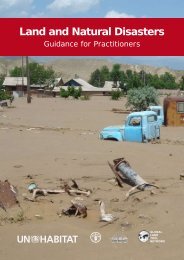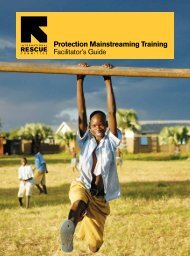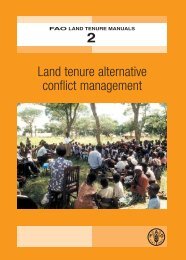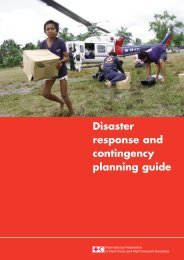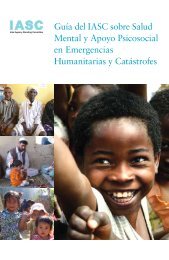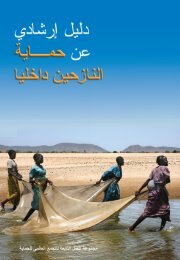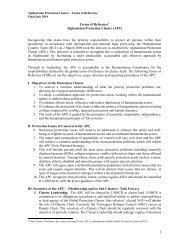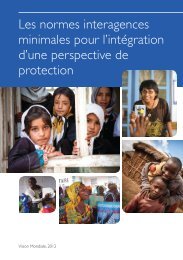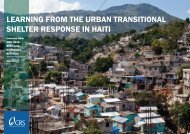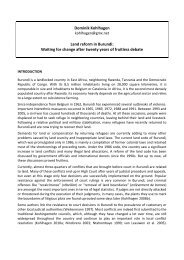Inter-Agency Real Time Evaluation of the Response to Cyclone Nargis
Inter-Agency Real Time Evaluation of the Response to Cyclone Nargis
Inter-Agency Real Time Evaluation of the Response to Cyclone Nargis
You also want an ePaper? Increase the reach of your titles
YUMPU automatically turns print PDFs into web optimized ePapers that Google loves.
individuals responding without any emergency experience – but also <strong>to</strong> <strong>the</strong> very real logisticaldifficulties <strong>of</strong> working in <strong>the</strong> affected areas, most <strong>of</strong> which were accessible only by air or boat (manyboats having been damaged or destroyed). Compounding <strong>the</strong> problem was that field levelcoordination was handicapped due <strong>to</strong> delays in deploying OCHA staff.Although early international media reports implied that <strong>the</strong> government was blocking aid <strong>to</strong> affectedpopulations, interviews and agency reports showed that local groups and even some internationalorganizations were able <strong>to</strong> access affected areas immediately after <strong>the</strong> cyclone. For example, oneinternational NGO had 28 medical teams in some <strong>of</strong> <strong>the</strong> most affected areas <strong>of</strong> Labutta Townshipwithin a few days after <strong>the</strong> cyclone. There were certainly very real restrictions on access, but evenso, those organizations already in <strong>the</strong> country that were less risk-averse and were less constrained byissues around national sovereignty reached affected populations soon after <strong>the</strong> cyclone. <strong>Inter</strong>nationalagencies were also quick <strong>to</strong> mobilizing funding, activate <strong>the</strong> clusters, and mount a concerteddiplomatic effort that eventually resulted in, among o<strong>the</strong>r things, <strong>the</strong> TCG and <strong>the</strong> air bridge inThailand that helped <strong>to</strong> expedite <strong>the</strong> delivery <strong>of</strong> aid.The government restrictions placed on international agencies were not imposed because <strong>of</strong> cyclone<strong>Nargis</strong>, but <strong>the</strong> effect was <strong>to</strong> limit <strong>the</strong> number <strong>of</strong> international agencies and staff responding. It issafe <strong>to</strong> assume that this fac<strong>to</strong>r decreased coverage <strong>of</strong> affected areas and probably prolonged sufferingin some communities. Due <strong>to</strong> <strong>the</strong> relatively small number <strong>of</strong> responders, <strong>the</strong> restrictions obligedseveral organizations (both NGOs and UN) <strong>to</strong> take on a relatively wide variety <strong>of</strong> sec<strong>to</strong>ral activities,going beyond <strong>the</strong> institutional technical expertise <strong>of</strong> agencies. At <strong>the</strong> same time, <strong>the</strong> team saw noevidence from agency reports/surveys or interviews that <strong>the</strong>re has been any epidemic or increase inacute malnutrition from pre-cyclone levels. While <strong>the</strong>re were post-cyclone deaths, based oninterviews with responders who were among <strong>the</strong> first arrivals in <strong>the</strong> Delta <strong>the</strong>re was no evidence <strong>of</strong> amassive second wave <strong>of</strong> preventable deaths as predicted by many international media reports in earlyMay.It is illuminating <strong>to</strong> draw fur<strong>the</strong>r comparisons with <strong>the</strong> tsunami response in Aceh, which was floodedwith hundreds <strong>of</strong> international NGOs staffed mainly by expatriates operating with private fundsraised from outside <strong>the</strong> country. Most <strong>of</strong> <strong>the</strong> aid workers in Aceh had never worked in Indonesiabefore <strong>the</strong> tsunami, had little emergency experience or relevant technical expertise. In Myanmar, due<strong>to</strong> limited restrictions on access, <strong>the</strong>se ‘fringe’ organizations were by and large not able <strong>to</strong> deploy.Stakeholder interviews and reports indicated that local organizations, local businesses, nationalcelebrities (musicians, ac<strong>to</strong>rs, etc.), schools and groups <strong>of</strong> private citizens had been able <strong>to</strong> mobilizesignificant amounts <strong>of</strong> private funds <strong>to</strong> complement funds that were being provided by <strong>the</strong> Myanmargovernment and neighboring countries. This translated in<strong>to</strong> a much more prominent role for localac<strong>to</strong>rs than in Aceh, aided by <strong>the</strong> relatively good access <strong>to</strong> <strong>the</strong> Delta from <strong>the</strong> main commercialcenter <strong>of</strong> Yangon.The result was impressive. Although hardly any <strong>of</strong> <strong>the</strong> (primarily national) individuals, privatebusinesses, student groups, and local agencies responding had previous disaster managementexperience, <strong>the</strong>y spoke <strong>the</strong> local language, unders<strong>to</strong>od what constituted a culturally appropriate reliefitem and knew how <strong>to</strong> interact with local authorities and communities. Findings <strong>of</strong> this IA RTEmirrored those <strong>of</strong> <strong>the</strong> TEC which suggested that most <strong>of</strong> <strong>the</strong> live-saving activities after cyclone<strong>Nargis</strong> were carried out by national ac<strong>to</strong>rs prior <strong>to</strong> <strong>the</strong> arrival <strong>of</strong> international agencies, but this timenational ac<strong>to</strong>rs were not pushed aside by an influx <strong>of</strong> international agencies under pressure <strong>to</strong>disburse funds quickly as was <strong>the</strong> case in Aceh.11



